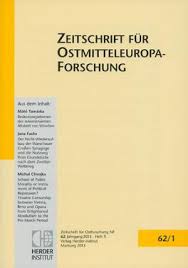Städtische Freiheit und die nichtdeutsche Bevölkerung. Livland und die Oberlausitz im Vergleich
Municipal liberty and the non-German population. A comparison of Livonia and Upper Lusatia
Author(s): Norbert KerskenSubject(s): History of Church(es), Ethnohistory, Political history, Social history, Middle Ages
Published by: Verlag Herder-Institut
Keywords: Municipal liberty; non-German population; comparison; Livonia and Upper Lusatia;
Summary/Abstract: Comparing regional histories is not a very well-developed method in research into East European history. Here, two constellations need to be distinguished: the comparison between two countries or regions featuring a close neighbourhood or historic relationship, and the comparison between countries and regions that do not have this feature but show common structures that allow for a distinctive comparison and help to draw a more distinct profile of the respective evidence for a regional history. This article is intended to attempt such a comparison with regard to Livonia and Upper Lusatia in the late Middle Ages. Both territories can be compared with respect to the chronology of their medieval history; they have a comparable constitutional structure and, in particular, show social similarities: With regard to the strong position of the towns and with regard to a strong indigenous population (the Livonians, Latvians and Estonians, as well as the Sorbs), who did not lose their ethnic identity in the wake of the colonization starting in the 13* Century. In both territories, the indigenous population participated in the colonization (in Livonia, there was practically no rural settlement of the Germans worth mentioning) and in the social life in the towns - even though subordinated. In neither territory was there a fundamental ethnic discrimination: In comparison to other regions, exclusive regulations concerning the citizenship and the guild charters were stipulated comparatively late; they were seldom and primarily of an economic nature (only since the late 14* Century). In the 16th Century, this constellation promoted the development of a native language culture, both under the conditions of the Reformation and within the Old Church.
Journal: Zeitschrift für Ostmitteleuropa-Forschung
- Issue Year: 57/2008
- Issue No: 1
- Page Range: 4-22
- Page Count: 19
- Language: German

